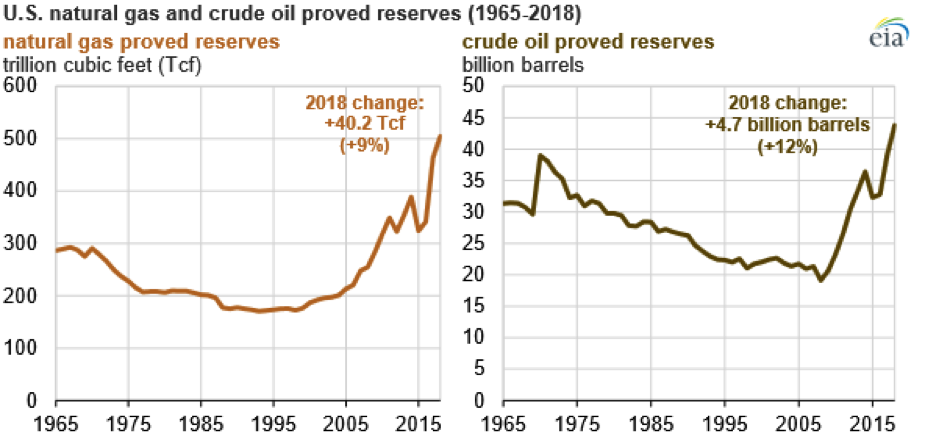According to the Energy Information Administration (EIA), U.S. proved reserves of crude oil and lease condensate increased to 47.1 billion barrels in 2018—a 12 percent increase compared with the previous record set at year-end 2017 of 42 billion barrels. U.S. proved reserves of natural gas increased to 504.5 trillion cubic feet—a 9 percent increase compared with the record level set in 2017 of 464.4 trillion cubic feet. Proved reserves are oil and natural gas quantities that geological and engineering data find with reasonable certainty to be recoverable from known reservoirs under existing economic and operating conditions. Reserves estimates change from year to year as new discoveries are made, existing fields are appraised, reserves are produced, prices and costs change, and technologies develop.

U.S. proved reserves of oil and natural gas have increased despite record production of these fuels in 2018. U.S. crude oil and lease condensate production increased 17 percent in 2018 to an average of 10.96 million barrels per day—1.6 million barrels per day more than in 2017. U.S. natural gas production increased 12 percent in 2018 to 89.9 billion cubic feet per day—10 billion cubic feet per day more than in 2017.
Spurring the increase in proved reserves and production were increased prices of oil and natural gas. In 2018, the annual average spot price for West Texas Intermediate crude oil increased from $51.03 per barrel in 2017 to $65.66 per barrel in 2018—a 29 percent increase. The annual average natural gas spot price at the Henry Hub in Louisiana increased from $2.99 per million British thermal units in 2017 to $3.35 per million British thermal units in 2018—a 12 percent increase.
Proved Reserves by State
The largest net increase in oil and natural gas proved reserves in 2018 was in Texas, totaling 2.3 billion barrels of crude oil and lease condensate proved reserves and 22.9 trillion cubic feet of natural gas proved reserves. The major share of that increase was located in the Wolfcamp and Bone Spring shale plays in the Permian Basin.
The next largest net gains in crude oil and lease condensate proved reserves in 2018 were in New Mexico and North Dakota. New Mexico’s crude oil and lease condensate proved reserves increased by 750 million barrels and North Dakota’s increased by 422 million barrels in 2018.
The next-largest net gains in natural gas proved reserves in 2018 were in Pennsylvania and New Mexico. Pennsylvania’s natural gas proved reserves located in the Marcellus shale play increased by 14.2 trillion cubic feet and New Mexico’s located in the Wolfcamp and Bone Spring shale plays increased by 4.2 trillion cubic feet in 2018.
Conclusion
The use of hydraulic fracturing in shale plays has increased both production and reserves of U.S. oil and natural gas. Not only are we seeing record production and reserves since fracking became a major technology in the oil and gas industry, but the record increases have made the United States the world’s largest producer and a net exporter of oil and natural gas, bringing energy independence and bolstering national security.